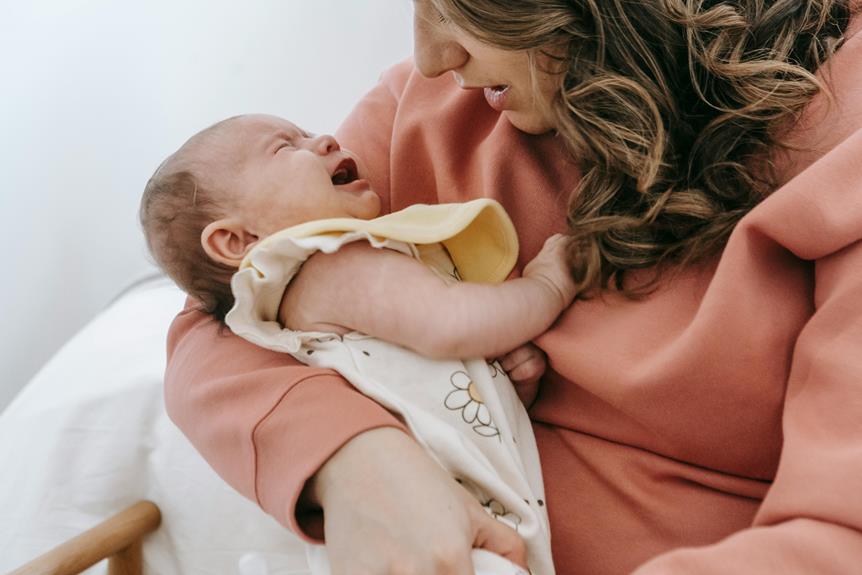
When your baby cries, they might be hungry, tired, uncomfortable, or seeking comfort. Pay attention to their cues like turning away or yawning to understand their needs better. Comfort your baby by rocking gently, using white noise, offering a pacifier, or creating a calming environment. By responding to your baby's unique signals, you can provide the care and comfort they need. Discover more ways to soothe your baby and strengthen your bond with them.
Common Reasons for Baby Crying
When babies cry, it's typically their way of communicating with you about their needs. One common reason for crying is hunger. Babies have small stomachs and need to eat frequently, so if it's been a couple of hours since their last feeding, they might be letting you know it's time for more milk or formula.
Another frequent cause of crying is tiredness. Babies, like adults, can get cranky when they're sleepy, so if they've been awake for a while, it might be time for a nap.
Additionally, babies cry when they're uncomfortable. This could be due to a wet diaper, feeling too hot or too cold, or even having a hair wrapped around a toe.
Sometimes babies cry simply because they need comfort and reassurance. Being held close, rocked gently, or hearing the sound of your voice can often help calm them down. By paying attention to your baby's cues, you can better understand and address their needs, which can help reduce crying episodes.
Understanding Your Babys Needs
To understand your baby's needs better, pay attention to their cues and signals. Babies communicate through various ways such as crying, facial expressions, body movements, and sounds. By observing these cues, you can better understand what your baby is trying to tell you. For example, if your baby turns their head away during feeding, they may be full or not hungry at that moment. Similarly, if they arch their back or clench their fists, they might be experiencing discomfort or need a diaper change.
Another important aspect of understanding your baby's needs is recognizing their sleep cues. Yawning, rubbing their eyes, or becoming fussy can indicate that your baby is tired and ready for a nap. By responding promptly to these signals, you can help your baby feel more secure and content.
In addition to basic needs like hunger, discomfort, or fatigue, babies also crave emotional connection and interaction. Spending quality time with your baby, talking to them, and engaging in activities like singing or gentle rocking can help meet their emotional needs and strengthen your bond. Remember, every baby is different, so it's essential to observe and learn your baby's unique cues to provide the best possible care and comfort.
Techniques for Comforting Your Baby
One effective way to comfort your baby is by gently swaying and patting their back to soothe them. The rhythmic motion can help calm your baby and make them feel secure. Additionally, holding your baby close to your chest while swaying can mimic the feeling of being in the womb, providing them with a sense of familiarity and comfort.
Another technique to comfort your baby is using white noise or gentle music to create a soothing environment. The soft sounds can help mask any sudden noises that might startle your baby and make them feel more relaxed. You can try using a white noise machine, a fan, or even play calming lullabies to help your baby settle down.
Furthermore, offering a pacifier to your baby can also provide comfort by satisfying their natural sucking reflex. The act of sucking can be soothing for babies and help them relax. Just make sure to use an age-appropriate pacifier and consult with your pediatrician if you have any concerns.
Creating a Calming Environment
For a peaceful atmosphere conducive to soothing your baby, consider dimming the lights and minimizing external stimuli. Soft, gentle lighting can help create a cozy environment that promotes relaxation. Loud noises and bright lights can be overwhelming for your little one, so it's beneficial to keep the environment calm and quiet.
Additionally, maintaining a comfortable temperature can also contribute to a calming atmosphere. Make sure the room is neither too hot nor too cold, as extreme temperatures can cause discomfort and distress for your baby. Swaddling your baby in a soft, breathable blanket can help regulate their body temperature and provide a sense of security.
Creating a soothing ambiance with soft background music or white noise can further enhance the calming environment. These gentle sounds can mask any sudden noises that might startle your baby and help them drift off to sleep more easily.
Conclusion
Next time your baby starts crying, remember that they may be trying to communicate their needs to you. By understanding the common reasons for crying, tuning into your baby's cues, and implementing calming techniques, you can provide comfort and support to your little one.
Creating a soothing environment can also help alleviate their distress. Trust your instincts and remember that every baby is unique – you've got this!




